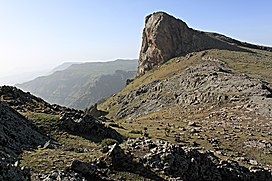Abuna Yosef (Amharic: አቡነ ዮሴፍ) is a prominent mountain in the Lasta massif of the Ethiopian Highlands. At 4,260 metres (13,976 ft) it is the 6th tallest mountain in Ethiopia and the 19th highest of Africa. It is located in the Semien Wollo Zone of the Amhara Region.
| Abuna Yosef | |
|---|---|
 Abuna Yosef peak | |
| Highest point | |
| Elevation | 4,260 m (13,980 ft)[1] |
| Prominence | 1,909 m (6,263 ft)[2] |
| Listing | Ultra |
| Coordinates | 12°08′27″N 39°10′54″E / 12.14083°N 39.18167°E[2] |
| Geography | |
| Location | Semien Wollo Zone, Ethiopia |
| Parent range | Ethiopian Highlands |
| Climbing | |
| Easiest route | Access through Wendatch (3500 m) |
Afro-alpine environment
editThe Abuna Yosef massif is home to Ethiopian wolves, Gelada baboons,[3] Erica arborea, Lobelia and other afro-alpine vegetation.[4]
The Abuna Yosef Community Conservation Area covers about 70 km2 of the Abuna Yosef massif.[5]
Major towns
editAt the eastern part of the mountain range, the town of Wandatch (on the Kobo - Lalibela road) is the main entry point to the Abuna Yosef afro-alpine massif.[6][7] At 3500 m above sea level, it is one of the most elevated towns in Ethiopia.
The towns of Muja, Kulmesq and Lalibela are located on the footslopes of the massif.
Monolithic churches on the footslopes
editA notable landmark on this mountain is the Church of Gennete Maryam, a monolithic church which tradition reports was excavated during the reign of Yekuno Amlak.[8] Also notable are four free-standing churches build inside caves in the mountain, the oldest and most famous being Yemrehana Krestos Church, built by the Zagwe king of the same name. The other three are Emakina Medhane Alem (probably built by Yekuno Amlak in the late 13th century), Lideta Maryam, and Zammadu Maryam (probably 15th century).[9] The churches of Lalibela lie in its foothills.
Climate
editDue to the mountain being having the 6th highest elevation in the country it makes it one of the coldest locations and in winter months temperatures nightfall temperatures are typically below freezing. However, due to the dry season also being during the months where temperature fall below freezing this causes a lack of snow on the mountain even though it occurs multiple times yearly.
| Climate data for Abuna Yosef | |||||||||||||
|---|---|---|---|---|---|---|---|---|---|---|---|---|---|
| Month | Jan | Feb | Mar | Apr | May | Jun | Jul | Aug | Sep | Oct | Nov | Dec | Year |
| Mean daily maximum °C (°F) | −0.4 (31.2) |
−0.1 (31.9) |
2.3 (36.2) |
4.4 (39.9) |
6.6 (43.8) |
9.1 (48.4) |
9.8 (49.7) |
9.4 (48.9) |
7.1 (44.8) |
5.9 (42.7) |
3.7 (38.6) |
1.1 (33.9) |
4.9 (40.8) |
| Mean daily minimum °C (°F) | −2.3 (27.8) |
−2.0 (28.4) |
−1.0 (30.2) |
0.9 (33.7) |
2.9 (37.3) |
5.2 (41.3) |
6.6 (43.9) |
6.4 (43.5) |
4.4 (39.9) |
2.2 (35.9) |
−0.1 (31.8) |
−1.4 (29.5) |
1.8 (35.3) |
| Source: Climate Data | |||||||||||||
See also
edit- List of Ultras of Africa (ultra prominent peaks)
References
edit- ^ "Abune Yosef, Ethiopia". Peakbagger.com. peakbagger.com
- ^ a b "Africa Ultra-Prominences" Peaklist.org. Retrieved 2012-01-15.
- ^ Eshete, G., Marino, J., & Sillero‐Zubiri, C. (2018). Ethiopian wolves conflict with pastoralists in small Afroalpine relicts. African Journal of Ecology, 56(2), 368-374.
- ^ Jacob, M., Frankl, A., Beeckman, H., Mesfin, G., Hendrickx, M., Guyassa, E., & Nyssen, J. (2015). North Ethiopian afro‐alpine tree line dynamics and forest‐cover change since the early 20th century. Land Degradation & Development, 26(7), 654-664.
- ^ Annual report Archived 2014-09-07 at the Wayback Machine. Ethiopian Wolf Conservation Programme. 2013. p. 9. Retrieved 24 May 2014.
- ^ Nyssen, J., Frankl, A., Munro, R. N., Billi, P., & Haile, M. (2010). Digital photographic archives for environmental and historical studies: an example from Ethiopia. Scottish Geographical Journal, 126(3), 185-207.
- ^ Hendrickx, H., Jacob, M., Frankl, A., Guyassa, E., & Nyssen, J. (2015). Quaternary glacial and periglacial processes in the Ethiopian Highlands in relation to the current afro-alpine vegetation. Zeitschrift für Geomorphologie, 37-57.
- ^ Philip Briggs, Ethiopia: The Bradt Travel Guide, 5th edition (Chalfont St Peters: Bradt, 2009), p. 368
- ^ Gervers, Michael. "An Architectural Survey of the Church of Emakina Madhane Alam (Lasta, Ethiopia)" (PDF). Retrieved 17 March 2014.
External links
edit- The Abune Yosef Massif: Birds and Mammals of a Hidden Jewel of Ethiopia. Universitat de Barcelona. 2009.
